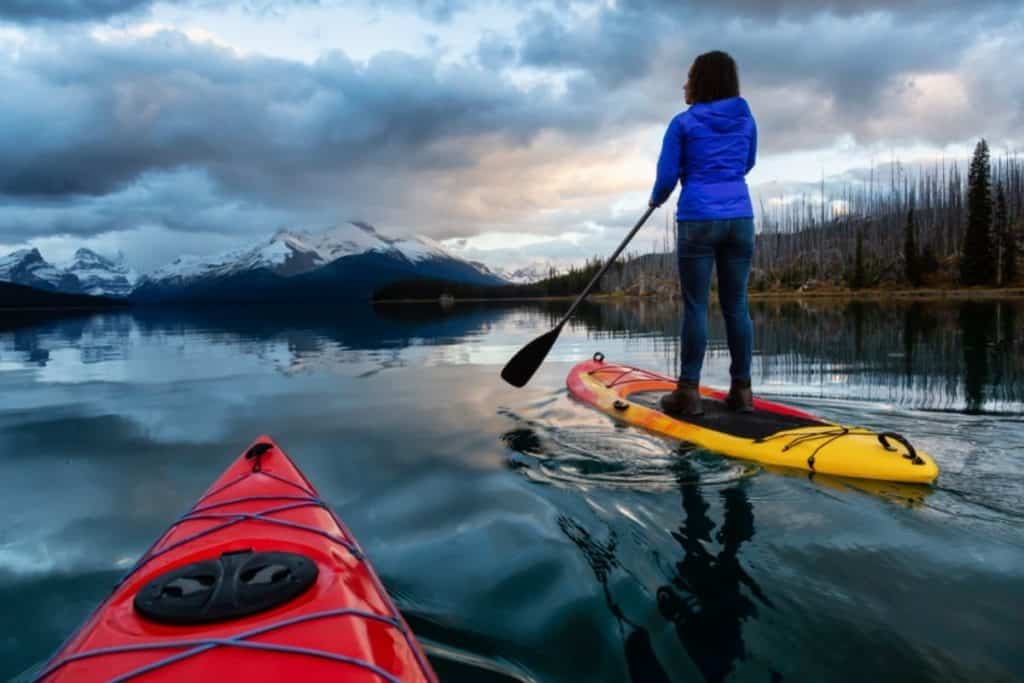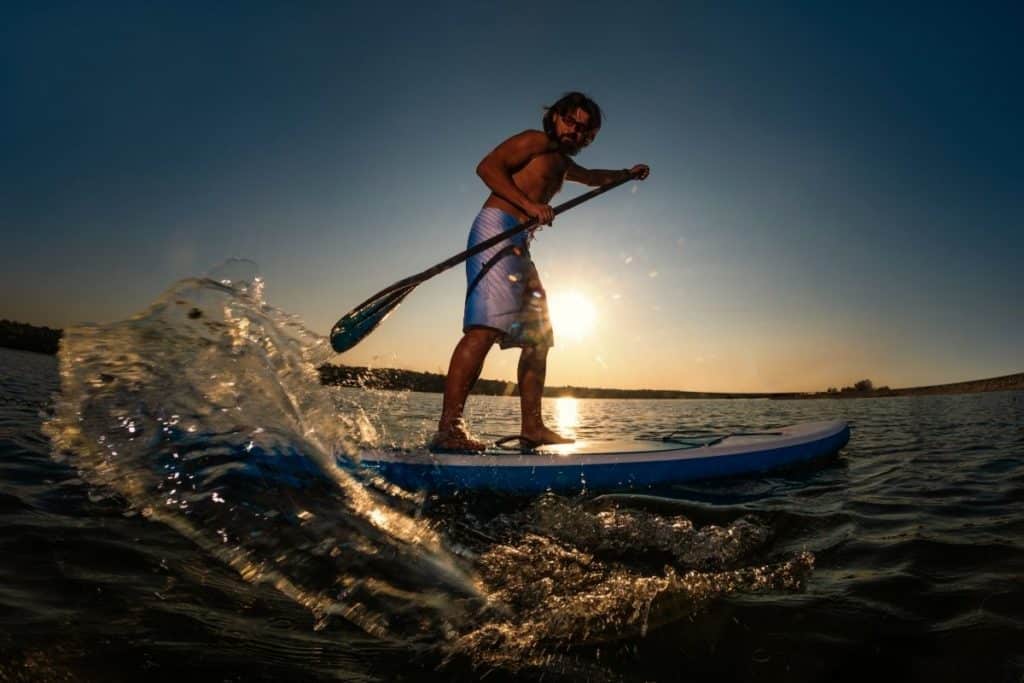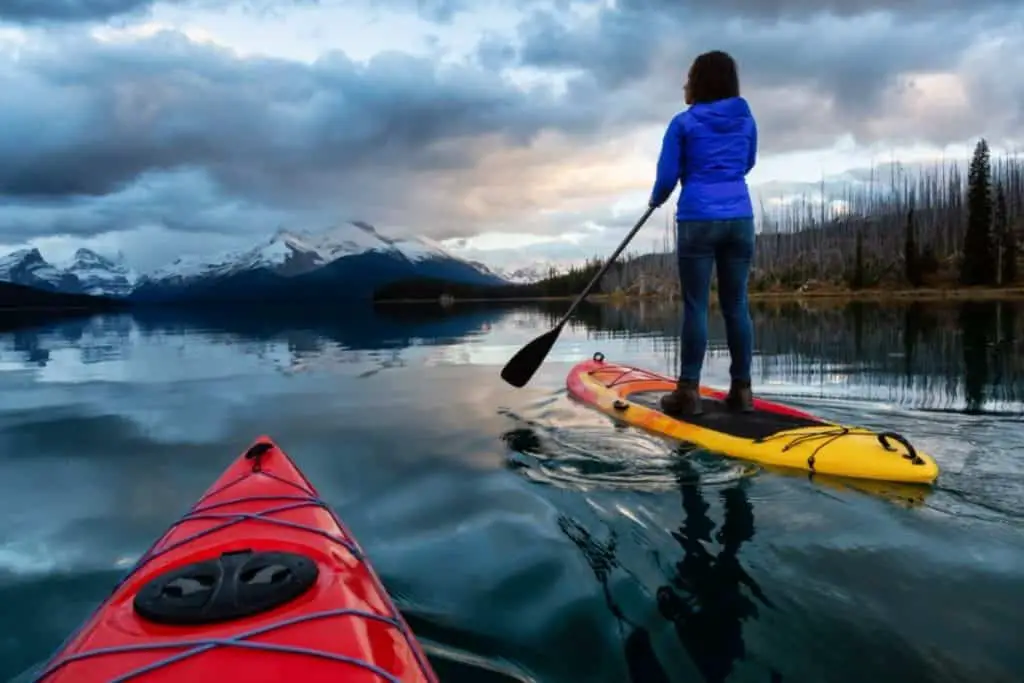As an Amazon Associate we earn from qualifying purchases.
Paddleboarding is one of the most peaceful things you can do on the water. Whether you’re alone or with friends, there is much fun to be had alongside the tranquility of nature.

However, there are times where you can fall off into the depths of the water, which can be really frustrating. But when floating on the water, it’s best to expect to get a little bit wet.
There’s no need to stress though, we have a guide for you on how to get back onto your paddleboard after falling into the water.
Table of Contents
How Big Are Paddleboards?
If you’re looking for a casual experience of cruising through the water with ease, then your standard paddleboard will be approximately six inches to eight inches taller than the person using the board.
For example, if you stand at six feet tall, then your paddleboard should be anywhere between 6 foot 6 inches and 6 foot 8 inches. This ensures that you’re not too big for the board and makes sure that it can hold your weight.
If you have a paddleboard that’s too small then you could disrupt the distribution of the weight and cause more falls than usual. The paddleboards should be anywhere between 32 and 34 inches wide.
This is for the same reason as the length so that you don’t affect the sharing of the weight and force yourself into taking an early bath!
Where Is Best To Paddleboard?
The beauty of paddleboarding is that you can find a good location on most bodies of water. Still-bodies such as lakes, canals, and large ponds can be a great place to have a relaxed journey and take some lunch with you.
This way if you’re with friends or family, or even on a solo adventure, you can take a waterproof music speaker of some sort and have a lovely time. However, remember not to disturb the fish beneath you. We’re on their turf after all!
Lots of people prefer to paddleboard on the oceans and even take snorkeling kits with them. This makes sure that you get to experience what it’s like on top of the ocean’s surface, as well as below.
You can feel what it’s like to be at one with the ocean, whilst admiring the beauty from all different angles. It’s always useful to pack a wetsuit as the cold ocean air can cause a few people to feel a bit chilly.
When paddleboarding on the ocean it’s always best to research the tide timings and the weather before taking to the water. This way you avoid strong winds and large waves, which can cause you to topple and fall off your board if you’re not careful.
This can also result in you being caught adrift out at sea. Because of the currents and the sheer size of the ocean, this can be a very dangerous situation to find yourself in.

How To Get Back On A Paddleboard After Falling
The most important thing to do after falling off your paddleboard is to make sure that you don’t panic. Everyone falls in the water at some point, it’s all about getting back on your board so you can get back to enjoying the wildlife.
Getting back onto a paddleboard can be easier for some than for others. We all look different and have different body types and weights, so it’s all about finding what’s best for you and how you feel most comfortable.
The last thing anyone needs is to pull a muscle or injure themselves because that’ll ruin your day and make paddleboarding extremely difficult for you for the rest of the day.
Stay Safe
Your health is the main thing here and as we previously mentioned, pulling a muscle or straining yourself won’t help a thing. It can help to bring a life jacket with you so that you stay buoyant after taking a fall.
This will help you to conserve energy that you may have used trying to keep yourself afloat. This can also ensure that if you hit something and injure yourself, you can swim easier and prevent straining or injuring yourself further.
Land Away From The Board
If you’re in a large body of water then it’s good practice to try and fall away from your board. A lot of paddleboards are hard and stiff, so landing on them can cause potential injuries.
Falling into an open space of water limits the potential injuries and keeps you out of harm’s way. If you can, try and keep the paddle away from your landing area so you don’t land on it. It may seem light, but it can cause injury.
Disorientation And Resurface
Falling into the water can make you lose the sense of your ups and downs, making you disorientated. This can happen frequently on water bodies with lots of waves and currents, making it harder to resurface.
It’s useful to use one of your hands to find the surface as you could be under something hard. The last thing you need is popping up and hitting your head on your board!
Getting Back On The Board
Once reorientated, make sure that there are no immediate threats, evaluate the situation. Swim back to your board if you’re further away than first hoped. Position yourself in the middle of your board and flip it back over if you need to.
A lot of boards tend to capsize during the fall. If there are wind and waves, use them to help you back up. Position yourself with them at your back so that you’re not fighting the elements to reset yourself. This also ensures that the board doesn’t flip over and hit you in the face.
Climbing back On
Using one hand, grab the side rail and use it to pull yourself up. If you can reach the opposite handle then it’ll be made a lot easier for you.
At the same time, kick your legs and use your body to thrust yourself onto the board to make sure you’re not solely relying on your arms. Make sure you’re facing the right way once on! From here you can kneel up and then stand on your feet.
Final Thoughts
The best thing to do when getting back on your board is to take it step-by-step and take your time.
Your health is of paramount importance and can be put at risk when panicking or rushing. Keep yourself calm and slowly make your way back to your board. Once you’re back on you can get back to enjoying yourself in peace!
Amazon and the Amazon logo are trademarks of Amazon.com, Inc, or its affiliates.

